Alnwick: Difference between revisions
mNo edit summary |
No edit summary |
||
| Line 9: | Line 9: | ||
| population = 7,767 | | population = 7,767 | ||
| census year = 2001 | | census year = 2001 | ||
| LG district= Northumberland | | LG district= Northumberland | ||
| constituency = Berwick-upon-Tweed | | constituency = Berwick-upon-Tweed | ||
| post town = Alnwick | | post town = Alnwick | ||
| Line 19: | Line 19: | ||
The town is mainly known as the location of Alnwick Castle, seat of the Dukes of Northumberland. | The town is mainly known as the location of Alnwick Castle, seat of the Dukes of Northumberland. | ||
Alnwick over the centuries has thrived as an agricultural centre. It stood on the Great North Road between [[Edinburgh]] and [[London]] until bypassed in the 1970s, and the presence of the castle, seat of the Earls and later Dukes of Northumberland gave it a pre-eminence. In | Alnwick over the centuries has thrived as an agricultural centre. It stood on the Great North Road between [[Edinburgh]] and [[London]] until bypassed in the 1970s, and the presence of the castle, seat of the Earls and later Dukes of Northumberland gave it a pre-eminence. In mediæval times the House of Percy, Earls of Northumberland, were the most powerful of the northern barons, and even into Elizabethan times the Percys retained their power. Latterly Anwick has transformed itself into modern rural centre. | ||
The fabric of the town centre has retained much of its old character and buildings, despite the growth of the town; new estates have been built on the edges of Alnwick on former pasture land and new factory and trading estate developments have been built along the roads to the south of the town. | The fabric of the town centre has retained much of its old character and buildings, despite the growth of the town; new estates have been built on the edges of Alnwick on former pasture land and new factory and trading estate developments have been built along the roads to the south of the town. | ||
| Line 53: | Line 53: | ||
'''The marketplace''' stands in and marks the centre of town is. It has an old market cross, and the relatively modern Northumberland Hall, used as a meeting place. Around the marketplace are the main shopping streets, Narrowgate, Fenkle Street, and Bondgate Within. The last of these is a wide, spacious road fronted by attractive commercial buildings. | '''The marketplace''' stands in and marks the centre of town is. It has an old market cross, and the relatively modern Northumberland Hall, used as a meeting place. Around the marketplace are the main shopping streets, Narrowgate, Fenkle Street, and Bondgate Within. The last of these is a wide, spacious road fronted by attractive commercial buildings. | ||
'''Hotspur Tower''' is a gate remaining from Alnwick's | '''Hotspur Tower''' is a gate remaining from Alnwick's mediæval walls. Times being as they were and prosperity unreliable, the walls were never completed. The Hotspur Tower was named for Sir Henry Percy, also called Harry Hotspur, the eldest son of the 1st Earl of Northumberland and a major character in [[Shakespeare]]'s ''Henry IV, Part 1''. It remains, a fine example of mediæval civic military architecture, dividing Bondgate Within from Bondgate Without. It is still used by traffic, though its width allows but a single carriageway. | ||
'''Pottergate Tower''' at the other side of the town also stands on the site of an ancient gate, but the tower itself was rebuilt in the 18th century. Its ornate spire was destroyed in a storm in 1812. | '''Pottergate Tower''' at the other side of the town also stands on the site of an ancient gate, but the tower itself was rebuilt in the 18th century. Its ornate spire was destroyed in a storm in 1812. | ||
| Line 86: | Line 86: | ||
*The Shrove Tuesday football match, known as ''Scoring the Hales'' played in the Pastures (the fields below the castle) between the parishes of St Paul and St Michaels. The ball is fetched from Alnwick Castle in procession, preceded by the Duke of Northumberland's piper. The game is won by whichever team is first to score two "hales" or goals. | *The Shrove Tuesday football match, known as ''Scoring the Hales'' played in the Pastures (the fields below the castle) between the parishes of St Paul and St Michaels. The ball is fetched from Alnwick Castle in procession, preceded by the Duke of Northumberland's piper. The game is won by whichever team is first to score two "hales" or goals. | ||
* The [http://www.alnwickfestival.com Alnwick International Music Festival] | * The [http://www.alnwickfestival.com Alnwick International Music Festival] | ||
* The Alnwick Castle Tournament – a | * The Alnwick Castle Tournament – a mediæval jousting spectacular in the grounds of Alnwick Castle | ||
* The Alnwick Fair has been discontinued as of 2007; it had some of appearance of | * The Alnwick Fair has been discontinued as of 2007; it had some of appearance of mediæval trading fairs and 17th century agricultural fairs. <ref> http://www.northumberlandgazette.co.uk/news/Death-of-the-Fair.3777345.jp Death of Alnwick Fair, retrieved 2010 August 23 </ref> There is no news of any revival. | ||
==References== | ==References== | ||
Latest revision as of 14:24, 18 July 2014
| Alnwick | |
| Northumberland | |
|---|---|
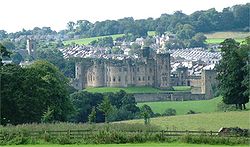 The town of Alnwick, nestling behind Alnwick Castle | |
| Location | |
| Grid reference: | NU186129 |
| Location: | 55°24’48"N, 1°42’25"W |
| Data | |
| Population: | 7,767 (2001) |
| Post town: | Alnwick |
| Postcode: | NE66 |
| Dialling code: | 01665 |
| Local Government | |
| Council: | Northumberland |
| Parliamentary constituency: |
Berwick-upon-Tweed |
Alnwick (pronounced ænɪk) is a small market town in northern Northumberland of some 8,000 people, 32 miles south of Berwick-upon-Tweed and 5 miles inland from the North Sea at Alnmouth.
The town is mainly known as the location of Alnwick Castle, seat of the Dukes of Northumberland.
Alnwick over the centuries has thrived as an agricultural centre. It stood on the Great North Road between Edinburgh and London until bypassed in the 1970s, and the presence of the castle, seat of the Earls and later Dukes of Northumberland gave it a pre-eminence. In mediæval times the House of Percy, Earls of Northumberland, were the most powerful of the northern barons, and even into Elizabethan times the Percys retained their power. Latterly Anwick has transformed itself into modern rural centre.
The fabric of the town centre has retained much of its old character and buildings, despite the growth of the town; new estates have been built on the edges of Alnwick on former pasture land and new factory and trading estate developments have been built along the roads to the south of the town.
According to Country Life, October 2002, "Alnwick is the most picturesque market town in Northumberland, and the best place to live in Britain".[1] The town is situated
History
Alnwick's name is of Anglo-Saxon origin, and it may have been built as long ago as 600 AD.
The real history of Alnwick though is the history of the castle and its lords, from the days of Gilbert Tyson (or Tison, Tisson, or De Tesson) one of William the Conqueror's standard-bearers, upon whom this northern estate was bestowed, until the present time. After being held by the family of De Vesci (of which the modern rendering is Vasey, a name found all over south-east Northumberland) for over two hundred years, it passed into the hands of the House of Percy in 1309.
At various points in the town are memorials of the constant wars between Percys and Scots in which so many Percys spent the greater part of their lives. A cross near Broomhouse Hill across the river from the castle marks the spot where Malcolm III of Scotland was killed in 1093, during the first Battle of Alnwick. At the side of the broad shady road called Rotten Row, leading from the West Lodge to Bailiffgate, a tablet of stone marks the spot where William the Lion, King of Scotland, was captured in 1174, during the second Battle of Alnwick by a party of about four hundred mounted knights, led by Ranulf de Glanvill; and there are many others of similar interest.
Hulne Priory, outside the town walls and within Hulne Park, the Duke's walled estate, was a Carmelite monastery founded in the 13th century (it is said that the site was chosen for some slight resemblance to Mount Carmel where the order originated). Substantial ruins remain.
In the winter of 1424, much of the town was burnt by a Scottish raiding party.
The accession of King James VI to the throne of England, and the effective union of the kingdoms this brought about, ended the reiver culture of Northumberland and the immediate threat of war. This allowed Alnwick and its lords to settle into a peaceful prosperity in which it has remained.
Sights in and about the town
Alnwick Castle
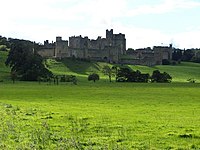
Alnwick Castle is the town's greatest building. It is one of the homes the Duke of Northumberland, and site of The Alnwick Garden. The castle dominates the west of the town, above the River Aln. It is the largest inhabited castle in England after Windsor Castle.
The Castle is the hub of a number of commercial, educational and tourism ventures. From 1945 to 1975, a teacher training college for young women and "mature students" was housed in the Castle, and today it houses American students studying in Europe. It is the headquarters of Northumberland Estates, the Duke's commercial enterprise. In its own right it is a tourist attraction.
The castle is open from April to September, and the Gardens all year around.
Benjamin Disraeli fictionalised Alnwick as 'Montacute' in his novel Tancred.
The town centre
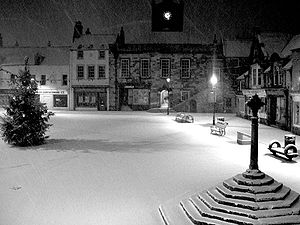
The marketplace stands in and marks the centre of town is. It has an old market cross, and the relatively modern Northumberland Hall, used as a meeting place. Around the marketplace are the main shopping streets, Narrowgate, Fenkle Street, and Bondgate Within. The last of these is a wide, spacious road fronted by attractive commercial buildings.
Hotspur Tower is a gate remaining from Alnwick's mediæval walls. Times being as they were and prosperity unreliable, the walls were never completed. The Hotspur Tower was named for Sir Henry Percy, also called Harry Hotspur, the eldest son of the 1st Earl of Northumberland and a major character in Shakespeare's Henry IV, Part 1. It remains, a fine example of mediæval civic military architecture, dividing Bondgate Within from Bondgate Without. It is still used by traffic, though its width allows but a single carriageway.
Pottergate Tower at the other side of the town also stands on the site of an ancient gate, but the tower itself was rebuilt in the 18th century. Its ornate spire was destroyed in a storm in 1812.
The Northumberland Fusiliers Museum is within Alnwick Castle.
The Pinfold is a stone circular structure within the centre of the town, built to hold stray cattle.
The old railway station building is quite ostentatious for such a small town, since it has seem many royal visitors visiting the Duke and Alnwick Castle. It is now a large secondhand bookshop.
The Bailiffgate Museum has a collection specifically dedicated to local social history; things agricultural, domestic, railway, coal mining, printing, a sizable photographic collection, paintings and the bound volumes of The Northumberland Gazettes.[2]
Art and culture
Alnwick has a thriving playhouse, a multi-purpose arts centre, which stages a hectic programme of theatre, dance, music, cinema, and visual arts exhibitions. The town also has its own weekly local newspaper—the Northumberland Gazette.
Around the town are found sports facilities; cricket, football, rugby, rambling, rock climbing, water sports, cycling and horse riding, an d thirteen golf courses within 30 minutes drive of the town.
Nearby
Places of interest in and near the town include:
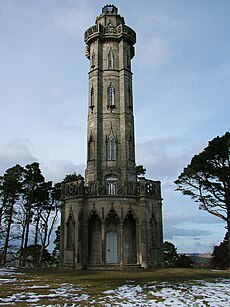
- Brizlee Tower, a Grade I listed folly tower set atop a hill in Hulne Park, the Duke's walled estate, designed by Robert Adam in 1777 and erected in 1781 for Hugh Percy, 1st Duke of Northumberland.
- The Nelson Memorial, Swarland, emphasising a local link to the admired Admiral.
- the White Swan Hotel, an 18th Century Coaching Inn that now houses the First Class Lounge and other fittings from the Titanic's sister ship RMS Olympic.
- RAF Boulmer, which serves as the base for an air-sea rescue helicopter, and has a role in early warning radar surveillance and communications.
- The Tenantry Column (similar in style to Nelson's Column), 83 feet tall and topped by the Percy Lion, symbol of the Percy family. It was designed by Charles Harper and erected for Hugh Percy, 2nd Duke of Northumberland in 1816 in gratitude to the Duke.
Yearly events
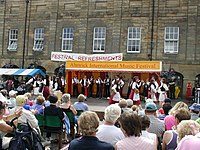
Major events in the Alnwick calendar include:
- The Shrove Tuesday football match, known as Scoring the Hales played in the Pastures (the fields below the castle) between the parishes of St Paul and St Michaels. The ball is fetched from Alnwick Castle in procession, preceded by the Duke of Northumberland's piper. The game is won by whichever team is first to score two "hales" or goals.
- The Alnwick International Music Festival
- The Alnwick Castle Tournament – a mediæval jousting spectacular in the grounds of Alnwick Castle
- The Alnwick Fair has been discontinued as of 2007; it had some of appearance of mediæval trading fairs and 17th century agricultural fairs. [3] There is no news of any revival.
References
- ↑ [1], Country Life Magazine.
- ↑ Bailiffgate Museum website
- ↑ http://www.northumberlandgazette.co.uk/news/Death-of-the-Fair.3777345.jp Death of Alnwick Fair, retrieved 2010 August 23
Outside links
- Alnwick described on the Keys to the Past website.
- Alnwick Castle
- Visit Northumberland